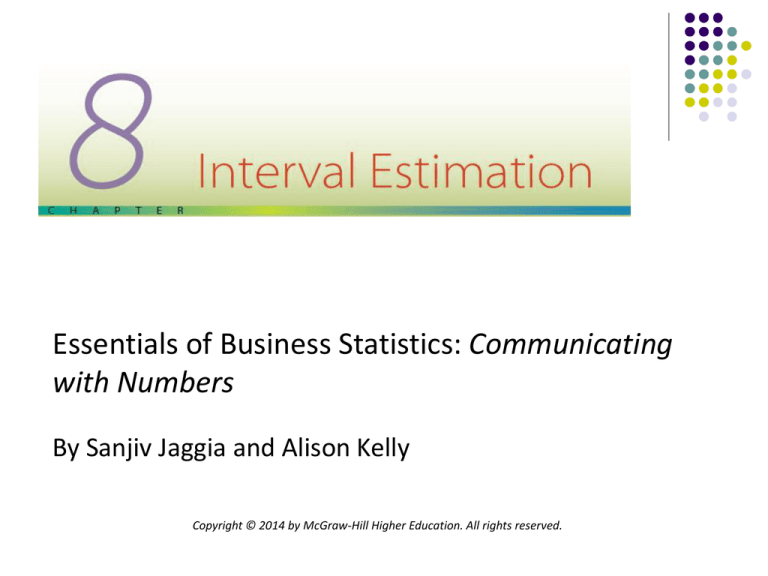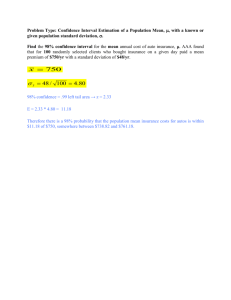
Essentials of Business Statistics: Communicating
with Numbers
By Sanjiv Jaggia and Alison Kelly
Copyright © 2014 by McGraw-Hill Higher Education. All rights reserved.
Chapter 8 Learning Objectives
LO 8.1
LO 8.2
LO 8.3
LO 8.4
LO 8.5
LO 8.6
LO 8.7
Explain an interval estimator.
Calculate a confidence interval for the population mean when
the population standard deviation is known.
Describe the factors that influence the width of a confidence
interval.
Discuss features of the t distribution.
Calculate a confidence interval for the population mean when
the population standard deviation is not known.
Calculate a confidence interval for the population proportion.
Select a sample size to estimate the population mean and the
population proportion.
Estimation
8-2
8.1 Interval Estimators
LO 8.1 Explain an interval estimator.
Confidence Interval—provides a range of values that,
with a certain level of confidence, contains the
population parameter of interest.
Also referred to as an interval estimate.
Construct a confidence interval as:
Point estimate ± Margin of error.
Margin of error accounts for the variability of the estimator
and the desired confidence level of the interval.
Estimation
8-3
8.1 Interval Estimators
LO 8.2 Calculate a confidence interval for the population mean when
the population standard deviation is known.
Constructing a Confidence Interval for m When s
is Known
Consider a standard normal random variable Z.
P 1.96 Z 1.96 0.95
as illustrated here.
Estimation
8-4
LO 8.2
8.1 Interval Estimators
Constructing a Confidence Interval for m When s is
Known
Since
Z
X m
s
n
X m
P 1.96
1.96 0.95
s n
We get
Which, after algebraically manipulating, is
equal to P m 1.96s n X m 1.96s n 0.95
Estimation
8-5
LO 8.2
8.1 Interval Estimators
Constructing a Confidence Interval for m When s
is Known
Note that P m 1.96s n X m 1.96s n 0.95
implies there is a 95% probability that the sample
mean X will fall within the interval m 1.96 s n
Thus, if samples of size n are drawn repeatedly
from a given population, 95% of the computed
sample means, x 's , will fall within the interval
and the remaining 5% will fall outside the
interval.
Estimation
8-6
LO 8.2
8.1 Interval Estimators
Constructing a Confidence Interval for m When s
is Known
Since we do not know m, we cannot determine if a
particularx falls within the interval or not.
However, we do know that x will fall within the
interval m 1.96 s n if and only if m falls within the
interval
x 1.96 s
.n
This will happen 95% of the time given the interval
construction. Thus, this is a 95% confidence interval for the
population mean.
Estimation
8-7
LO 8.2
8.1 Interval Estimators
Constructing a Confidence Interval for m When s
is Known
Level of significance (i.e., probability of error) = a.
Confidence coefficient = (1 a)
Confidence level = 100(1 a)%
A 100(1-a)% confidence interval of the population
mean m when the standard deviation s is known
is computed as x za 2 s n
or equivalently,
x za 2 s
Estimation
n , x za 2 s.
n
8-8
LO 8.2
8.1 Interval Estimators
Constructing a Confidence Interval for m When s
is Known
za/2 is the z value associated
with the probability of a/2
in the upper-tail.
x za 2 s
n , x za 2 s
n
Confidence Intervals:
90%, a = 0.10, a/2 = 0.05, za/2 = z.05 = 1.645.
95%, a = 0.05, a/2 = 0.025, za/2 = z.025 = 1.96.
99%, a = 0.01, a/2 = 0.005, za/2 = z.005 = 2.575.
Estimation
8-9
LO 8.2
8.1 Interval Estimators
Interpreting a Confidence Interval
Interpreting a confidence interval requires care.
Incorrect: The probability that m falls in the interval is
0.95.
Correct: If numerous samples of size n are drawn from
a given population, then 95% of the intervals formed
by the formula x za 2 s n will contain m.
Since there are many possible samples, we will be
right 95% of the time, thus giving us 95%
confidence.
Estimation
8-10
8.1 Interval Estimators
LO 8.3 Describe the factors that influence the width of a confidence
interval.
The Width of a Confidence Interval
Margin of Error
za 2 s
Confidence Interval Width
2 za 2 s
n
n
The width of the confidence interval is
influenced by the:
Sample size n.
Standard deviation s.
Confidence level 100(1 a)%.
Estimation
8-11
LO 8.3
8.1 Interval Estimators
The Width of a Confidence Interval is influenced by:
I. For a given confidence level 100(1 a)% and sample size n,
the width of the interval is wider, the greater the population
standard deviation s.
Example: Let the standard deviation of the population of
cereal boxes of Granola Crunch be 0.05 instead of 0.03.
Compute a 95% confidence interval based on the same
sample information.
x za 2 s
n 1.02 1.96 0.05
25 1.02 0.20
This confidence interval width has increased from 0.024 to
2(0.020) = 0.040.
Estimation
8-12
LO 8.3
8.1 Interval Estimators
The Width of a Confidence Interval is influenced by:
II. For a given confidence level 100(1 a)% and population
standard deviation s, the width of the interval is wider, the
smaller the sample size n.
Example: Instead of 25 observations, let the sample be based
on 16 cereal boxes of Granola Crunch. Compute a 95%
confidence interval using a sample mean of 1.02 pounds and
a population standard deviation of 0.03.
x za 2 s
n 1.02 1.96 0.03
16 1.02 0.015
This confidence interval width has increased from 0.024 to
2(0.015) = 0.030.
Estimation
8-13
LO 8.3
8.1 Interval Estimators
The Width of a Confidence Interval is influenced by:
III. For a given sample size n and population standard deviation
s, the width of the interval is wider, the greater the
confidence level 100(1 a)%.
Example: Instead of a 95% confidence interval, compute a
99% confidence interval based on the information from the
sample of Granola Crunch cereal boxes.
x za 2 s
n 1.02 2.575 0.03
25 1.02 0.015
This confidence interval width has increased from 0.024 to
2(0.015) = 0.030.
Estimation
8-14
8.2 Confidence Interval of the
Population Mean When s Is Unknown
LO 8.4 Discuss features of the t distribution.
The t Distribution
If repeated samples of size n are taken from a normal
population with a finite variance, then the
statistic T follows the t distribution
X m
with (n 1) degrees of freedom, df. T
S n
Degrees of freedom determine
the extent of the broadness of the tails of the
distribution; the fewer the degrees of freedom,
the broader the tails.
Estimation
8-15
LO 8.4
8.2 Confidence Interval of the
Population Mean When s Is
Unknown
Summary of the tdf Distribution
Bell-shaped and symmetric around 0 with asymptotic tails
(the tails get closer and closer to the horizontal axis, but
never touch it).
Has slightly broader tails than the z distribution.
Consists of a family of distributions where the actual shape of
each one depends on the df. As df increases, the tdf
distribution becomes similar to the z distribution; it is
identical to the z distribution when df approaches infinity.
Estimation
8-16
LO 8.4
8.2 Confidence Interval of the
Population Mean When s Is
Unknown
The tdf Distribution with Various Degrees of
Freedom
Estimation
8-17
8.2 Confidence Interval for the Population
Mean When s Is Unknown
LO 8.5 Calculate a confidence interval for the population mean when
the population standard deviation is not known.
Constructing a Confidence Interval for m When s is
Unknown
A 100(1 a)% confidence interval of the population mean
m when the population standard deviation s is not known
is computed as x t
s n
a 2,df
or equivalently, x t
a 2,df s
n , x ta 2,df s
n
where s is the sample standard deviation.
Estimation
8-18
8.3 Confidence Interval for the Population
Proportion
LO 8.6 Calculate a confidence interval for the population proportion.
Let the parameter p represent the proportion of
successes in the population, where success is defined
by a particular outcome.
P is the point estimator of the population proportion
p.
By the central limit theorem, P can be approximated
by a normal distribution for large samples (i.e., np > 5
and n(1 p) > 5).
Estimation
8-19
LO 8.6
8.3 Confidence Interval for the
Population Proportion
Thus, a 100(1a)% confidence interval of the
population proportion is
p za 2
p 1 p
n
or
p 1 p
p 1 p
p za 2
, p za 2
n
n
where p is used to estimate the population
parameter p.
Estimation
8-20
8.4 Selecting the Required Sample Size
LO 8.7 Select a sample size to estimate the population mean and the
population proportion.
Precision in interval estimates is implied by a
low margin of error.
A larger n reduces the margin of error for the
interval estimates.
How large should the sample size be for a given
margin of error?
Estimation
8-21
LO 8.7
8.4 Selecting the Required Sample
Size
Selecting n to estimate m
Consider a confidence interval for m with a
known s and let E denote the desired margin of
error.
Since E z σ n
α 2
we may rearrange to get
zα 2 σ
n
E
2
If s is unknown, estimate it with sˆ .
Estimation
8-22
LO 8.7
8.4 Selecting the Required Sample
Size
Selecting n to estimate m
For a desired margin of error E, the minimum
sample size n required to estimate a 100(1 a)%
confidence interval of the population mean m is
zα 2 σˆ
n
E
2
Where sˆ is a reasonable estimate of s in the
planning stage.
Estimation
8-23
LO 8.7
8.4 Selecting the Required Sample
Size
Selecting n to estimate p
Consider a confidence interval for p and let E
denote the desired margin of error.
Since
where p is the
p 1 p
E zα 2
sample proportion
n
2
zα 2
p 1 p
n
E
we may rearrange to get
Since p comes from a sample, we must use a
reasonable estimate of p, that is, p̂.
Estimation
8-24
LO 8.7
8.4 Selecting the Required Sample
Size
Selecting n to estimate p
For a desired margin of error E, the minimum
sample size n required to estimate a 100(1 a)%
confidence interval of the population proportion
2
p is
z
α 2
pˆ 1 pˆ
n
E
Where p̂ is a reasonable estimate of p in the
planning stage.
Estimation
8-25







